ВУЗ: Не указан
Категория: Не указан
Дисциплина: Не указана
Добавлен: 01.04.2021
Просмотров: 1451
Скачиваний: 7
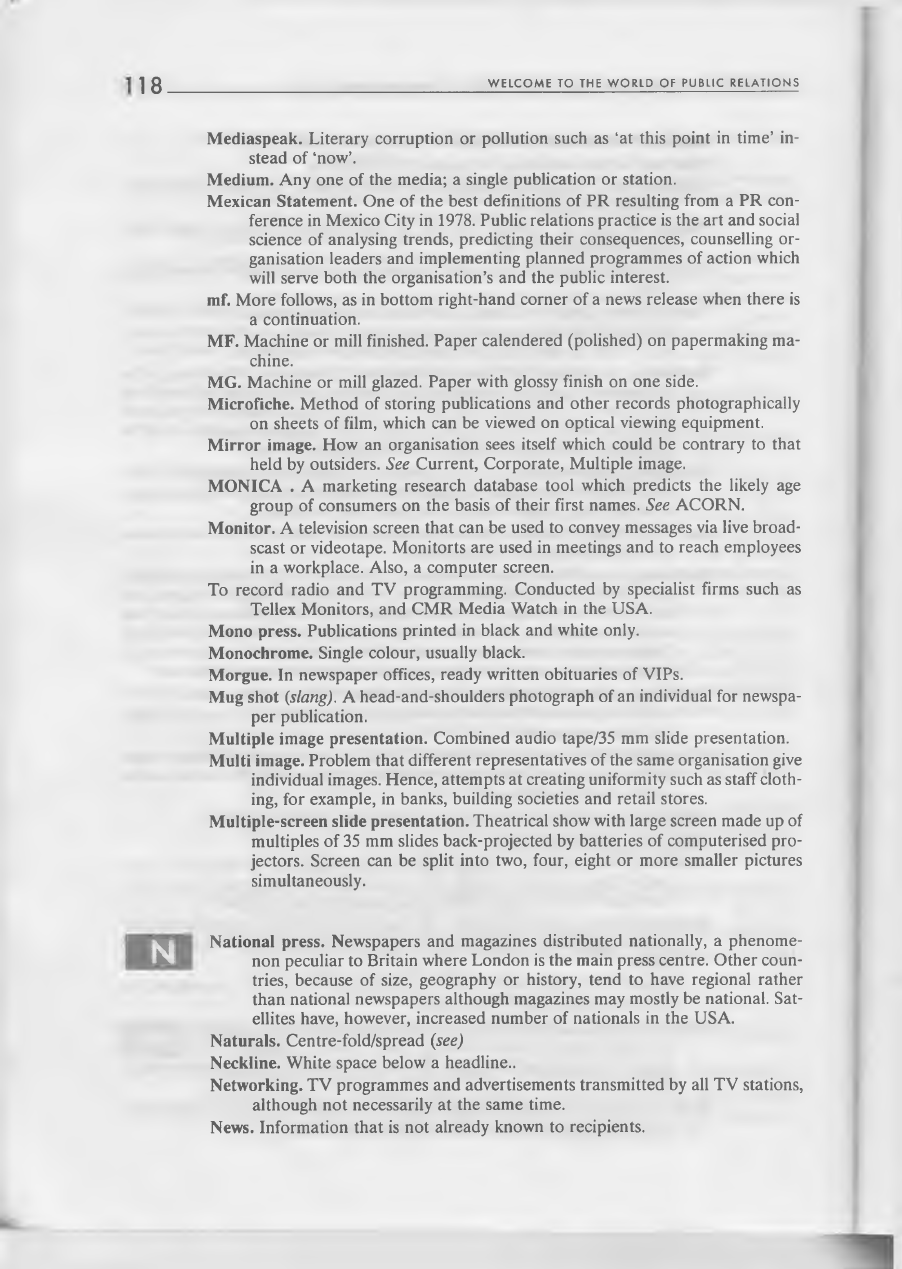
18
W E L C O M E T O T H E W O R L D O F P U B L I C R E L A T I O N S
Mediaspeak.
Literary corruption or pollution such as ‘at this point in time’ in
stead of ‘now’.
Medium.
Any one of the media; a single publication or station.
Mexican Statement.
One of the best definitions of PR resulting from a PR con
ference in Mexico City in 1978. Public relations practice is the art and social
science of analysing trends, predicting their consequences, counselling or
ganisation leaders and implementing planned programmes of action which
will serve both the organisation’s and the public interest.
mf. More follows, as in bottom right-hand corner of a news release when there is
a continuation.
MF.
Machine or mill finished. Paper calendered (polished) on papermaking ma
chine.
MG. Machine or mill glazed. Paper with glossy finish on one side.
Microfiche.
Method of storing publications and other records photographically
on sheets of film, which can be viewed on optical viewing equipment.
Mirror image.
How an organisation sees itself which could be contrary to that
held by outsiders.
See
Current, Corporate, Multiple image.
MONICA
. A marketing research database tool which predicts the likely age
group of consumers on the basis of their first names.
See
ACORN.
Monitor.
A television screen that can be used to convey messages via live broad-
scast or videotape. Monitorts are used in meetings and to reach employees
in a workplace. Also, a computer screen.
To record radio and TV programming. Conducted by specialist firms such as
Tellex Monitors, and CMR Media Watch in the USA.
Mono press.
Publications printed in black and white only.
Monochrome.
Single colour, usually black.
Morgue.
In newspaper offices, ready written obituaries of VIPs.
Mug shot (slang).
A head-and-shoulders photograph of an individual for newspa
per publication.
Multiple image presentation.
Combined audio tape/35 mm slide presentation.
Multi image.
Problem that different representatives of the same organisation give
individual images. Hence, attempts at creating uniformity such as staff cloth
ing, for example, in banks, building societies and retail stores.
Multiple-screen slide presentation.
Theatrical show with large screen made up of
multiples of 35 mm slides back-projected by batteries of computerised pro
jectors. Screen can be split into two, four, eight or more smaller pictures
simultaneously.
N
National press.
Newspapers and magazines distributed nationally, a phenome
non peculiar to Britain where London is the main press centre. Other coun
tries, because of size, geography or history, tend to have regional rather
than national newspapers although magazines may mostly be national. Sat
ellites have, however, increased number of nationals in the USA.
Naturals.
Centre-fold/spread
(see)
Neckline.
White space below a headline..
Networking.
TV programmes and advertisements transmitted by all TV stations,
although not necessarily at the same time.
News.
Information that is not already known to recipients.
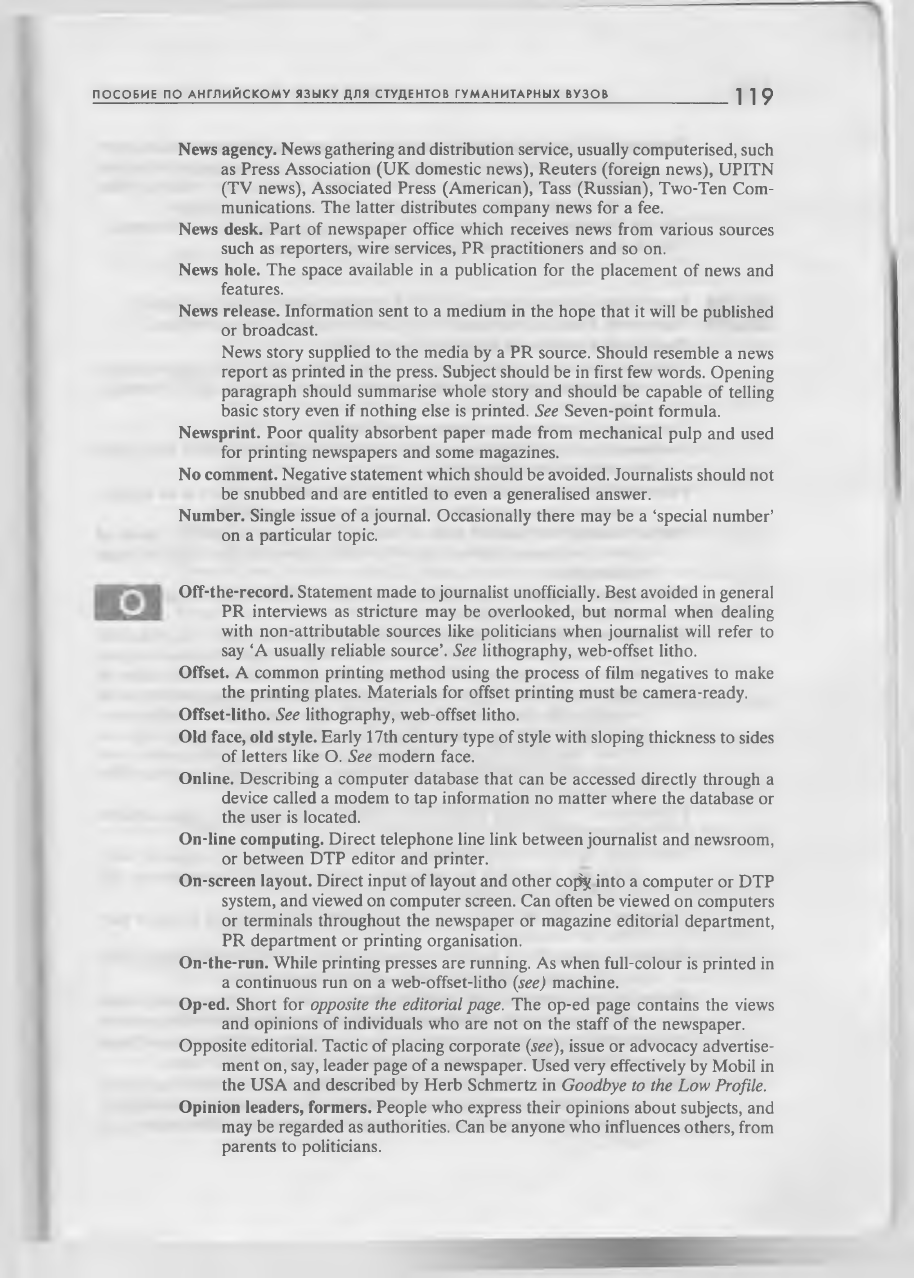
П О С О Б И Е П О А Н Г Л И Й С К О М У Я З Ы К У Д Л Я С Т У Д Е Н Т О В Г У М А Н И Т А Р Н Ы Х В У З О В
119
News agency.
News gathering and distribution service, usually computerised, such
as Press Association (UK domestic news), Reuters (foreign news), UPITN
(TV news), Associated Press (American), Tass (Russian), Two-Ten Com
munications. The latter distributes company news for a fee.
News desk.
Part of newspaper office which receives news from various sources
such as reporters, wire services, PR practitioners and so on.
News hole.
The space available in a publication for the placement of news and
features.
News release.
Information sent to a medium in the hope that it will be published
or broadcast.
News story supplied to the media by a PR source. Should resemble a news
report as printed in the press. Subject should be in first few words. Opening
paragraph should summarise whole story and should be capable of telling
basic story even if nothing else is printed.
See
Seven-point formula.
Newsprint.
Poor quality absorbent paper made from mechanical pulp and used
for printing newspapers and some magazines.
No comment.
Negative statement which should be avoided. Journalists should not
be snubbed and are entitled to even a generalised answer.
Number.
Single issue of a journal. Occasionally there may be a ‘special number’
on a particular topic.
Off-the-record.
Statement made to journalist unofficially. Best avoided in general
PR interviews as stricture may be overlooked, but normal when dealing
with non-attributable sources like politicians when journalist will refer to
say ‘A usually reliable source’.
See
lithography, web-offset litho.
Offset.
A common printing method using the process of film negatives to make
the printing plates. Materials for offset printing must be camera-ready.
Offset-litho. See
lithography, web-offset litho.
Old face, old style.
Early 17th century type of style with sloping thickness to sides
of letters like O.
See
modern face.
Online.
Describing a computer database that can be accessed directly through a
device called a modem to tap information no matter where the database or
the user is located.
On-line computing.
Direct telephone line link between journalist and newsroom,
or between DTP editor and printer.
On-screen layout.
Direct input of layout and other coji^ into a computer or DTP
system, and viewed on computer screen. Can often be viewed on computers
or terminals throughout the newspaper or magazine editorial department,
PR department or printing organisation.
On-the-run.
While printing presses are running. As when full-colour is printed in
a continuous run on a web-offset-litho
(see)
machine.
Op-ed.
Short for
opposite the editorial page.
The op-ed page contains the views
and opinions of individuals who are not on the staff of the newspaper.
Opposite editorial. Tactic of placing corporate
(see),
issue or advocacy advertise
ment on, say, leader page of a newspaper. Used very effectively by Mobil in
the USA and described by Herb Schmertz in
Goodbye to the Low Profile.
Opinion leaders, formers.
People who express their opinions about subjects, and
may be regarded as authorities. Can be anyone who influences others, from
parents to politicians.
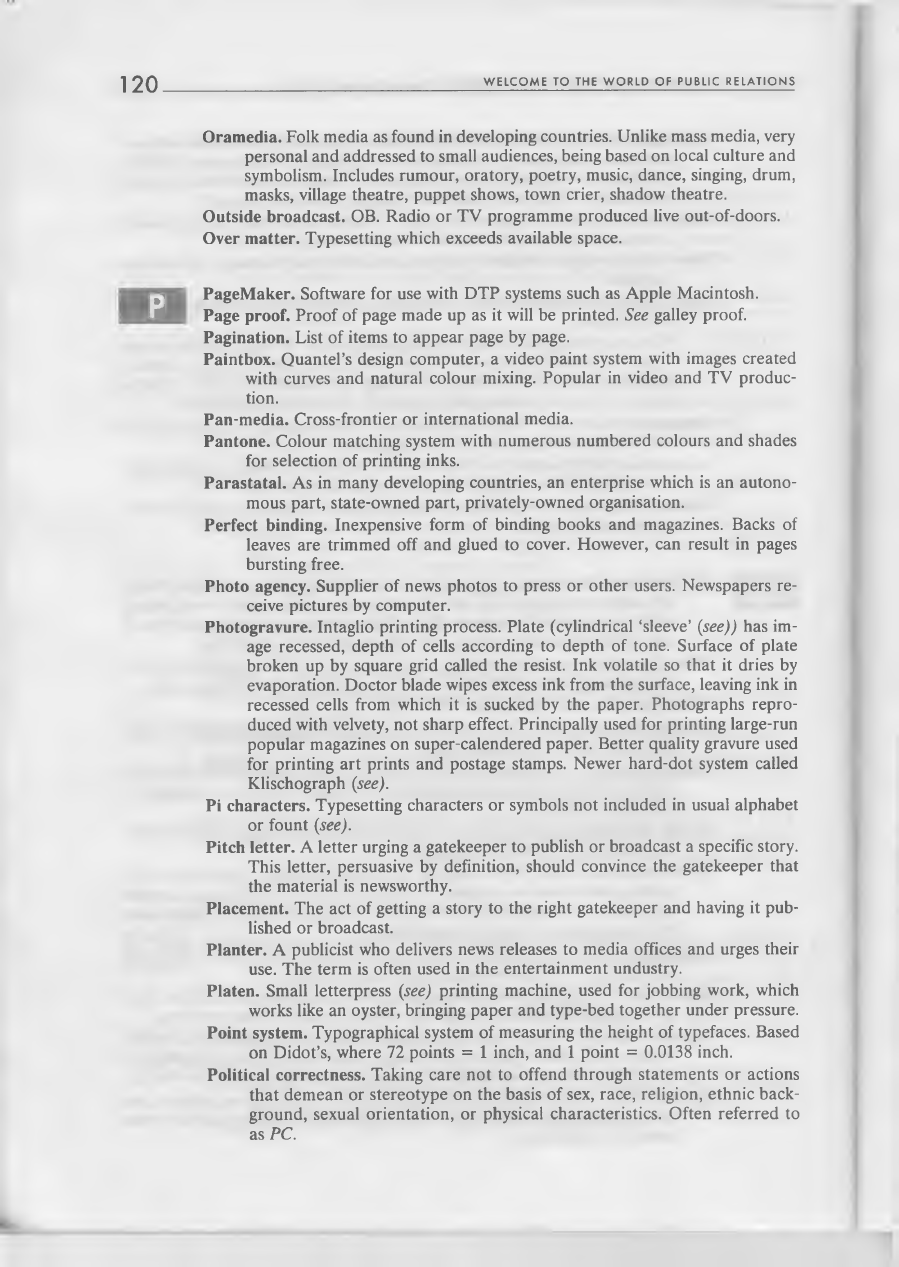
120
W E L C O M E T O T H E W O R L D O F P U B L I C R E L A T I O N S
Oramedia.
Folk media as found in developing countries. Unlike mass media, very
personal and addressed to small audiences, being based on local culture and
symbolism. Includes rumour, oratory, poetry, music, dance, singing, drum,
masks, village theatre, puppet shows, town crier, shadow theatre.
Outside broadcast.
OB. Radio or TV programme produced live out-of-doors.
Over matter.
Typesetting which exceeds available space.
P
PageMaker.
Software for use with DTP systems such as Apple Macintosh.
Page proof.
Proof of page made up as it will be printed.
See
galley proof.
Pagination.
List of items to appear page by page.
Paintbox.
Quantel’s design computer, a video paint system with images created
with curves and natural colour mixing. Popular in video and TV produc
tion.
Pan-media.
Cross-frontier or international media.
Pantone.
Colour matching system with numerous numbered colours and shades
for selection of printing inks.
Parastatal.
As in many developing countries, an enterprise which is an autono
mous part, state-owned part, privately-owned organisation.
Perfect binding.
Inexpensive form of binding books and magazines. Backs of
leaves are trimmed off and glued to cover. However, can result in pages
bursting free.
Photo agency.
Supplier of news photos to press or other users. Newspapers re
ceive pictures by computer.
Photogravure.
Intaglio printing process. Plate (cylindrical ‘sleeve’
(see))
has im
age recessed, depth of cells according to depth of tone. Surface of plate
broken up by square grid called the resist. Ink volatile so that it dries by
evaporation. Doctor blade wipes excess ink from the surface, leaving ink in
recessed cells from which it is sucked by the paper. Photographs repro
duced with velvety, not sharp effect. Principally used for printing large-run
popular magazines on super-calendered paper. Better quality gravure used
for printing art prints and postage stamps. Newer hard-dot system called
Klischograph
(see).
Pi characters.
Typesetting characters or symbols not included in usual alphabet
or fount
(see).
Pitch letter.
A letter urging a gatekeeper to publish or broadcast a specific story.
This letter, persuasive by definition, should convince the gatekeeper that
the material is newsworthy.
Placement.
The act of getting a story to the right gatekeeper and having it pub
lished or broadcast.
Planter.
A publicist who delivers news releases to media offices and urges their
use. The term is often used in the entertainment undustry.
Platen.
Small letterpress
(see)
printing machine, used for jobbing work, which
works like an oyster, bringing paper and type-bed together under pressure.
Point system.
Typographical system of measuring the height of typefaces. Based
on Didot’s, where 72 points = 1 inch, and 1 point = 0.0138 inch.
Political correctness.
Taking care not to offend through statements or actions
that demean or stereotype on the basis of sex, race, religion, ethnic back
ground, sexual orientation, or physical characteristics. Often referred to
as
PC.
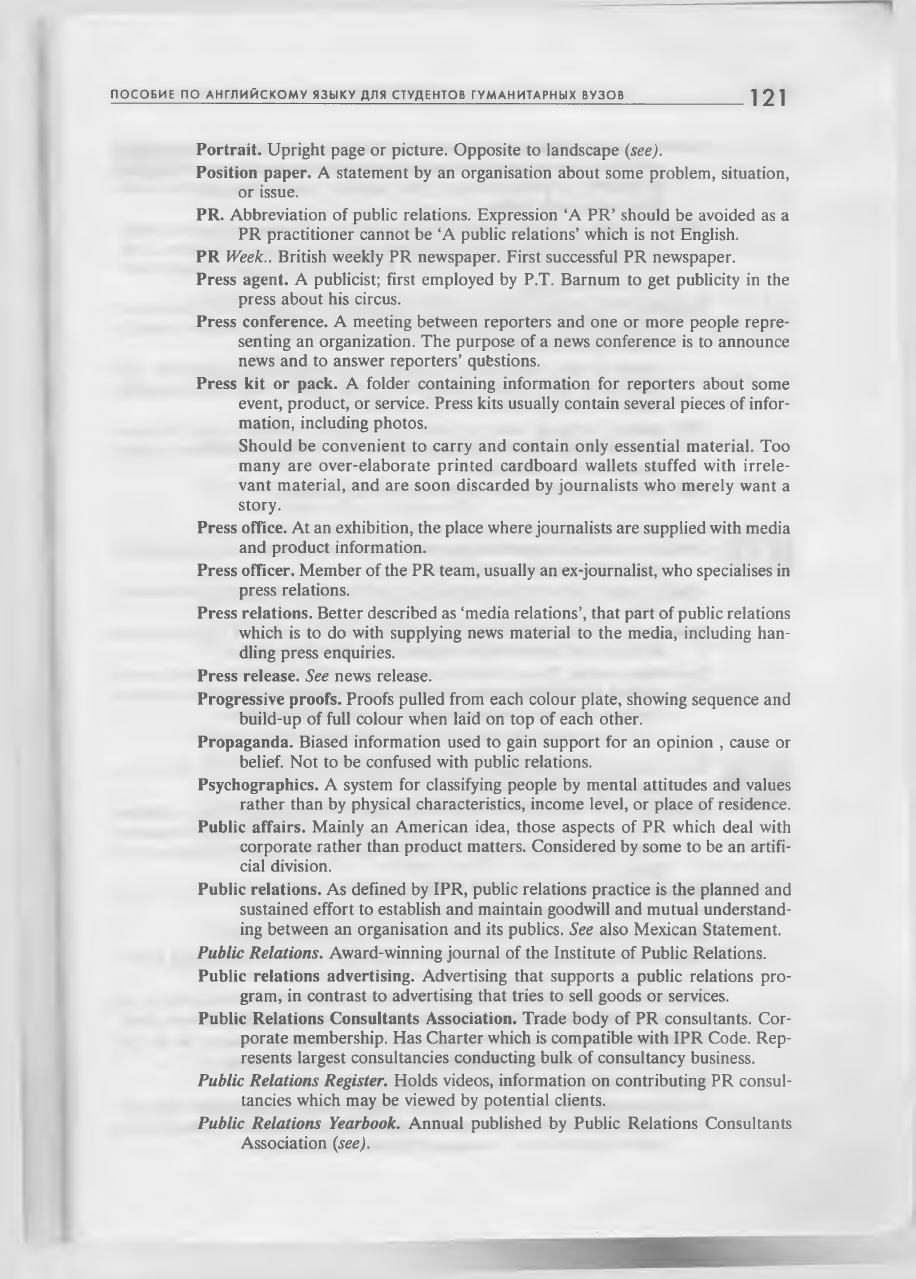
П О С О Б И Е П О А Н Г Л И Й С К О М У Я З Ы К У Д Л Я С Т У Д Е Н Т О В Г У М А Н И Т А Р Н Ы Х В У З О В
121
Portrait.
Upright page or picture. Opposite to landscape
(see).
Position paper.
A statement by an organisation about some problem, situation,
or issue.
PR.
Abbreviation of public relations. Expression ‘A PR ’ should be avoided as a
PR practitioner cannot be ‘A public relations’ which is not English.
PR Week..
British weekly PR newspaper. First successful PR newspaper.
Press agent.
A publicist; first employed by P.T. Barnum to get publicity in the
press about his circus.
Press conference.
A meeting between reporters and one or more people repre
senting an organization. The purpose of a news conference is to announce
news and to answer reporters’ questions.
Press kit or pack. A
folder containing information for reporters about some
event, product, or service. Press kits usually contain several pieces of infor
mation, including photos.
Should be convenient to carry and contain only essential material. Too
many are over-elaborate printed cardboard wallets stuffed with irrele
vant material, and are soon discarded by journalists who merely want a
story.
Press office.
At an exhibition, the place where journalists are supplied with media
and product information.
Press officer.
Member of the PR team, usually an ex-journalist, who specialises in
press relations.
Press relations.
Better described as ‘media relations’, that part of public relations
which is to do with supplying news material to the media, including han
dling press enquiries.
Press release. See
news release.
Progressive proofs.
Proofs pulled from each colour plate, showing sequence and
build-up of full colour when laid on top of each other.
Propaganda.
Biased information used to gain support for an opinion , cause or
belief. Not to be confused with public relations.
Psychographics.
A system for classifying people by mental attitudes and values
rather than by physical characteristics, income level, or place of residence.
Public affairs.
Mainly an American idea, those aspects of PR which deal with
corporate rather than product matters. Considered by some to be an artifi
cial division.
Public relations.
As defined by IPR, public relations practice is the planned and
sustained effort to establish and maintain goodwill and mutual understand
ing between an organisation and its publics.
See
also Mexican Statement.
Public Relations.
Award-winning journal of the Institute of Public Relations.
Public relations advertising.
Advertising that supports a public relations pro
gram, in contrast to advertising that tries to sell goods or services.
Public Relations Consultants Association.
Trade body of PR consultants. Cor
porate membership. Has Charter which is compatible with IPR Code. Rep
resents largest consultancies conducting bulk of consultancy business.
Public Relations Register.
Holds videos, information on contributing PR consul
tancies which may be viewed by potential clients.
Public Relations Yearbook.
Annual published by Public Relations Consultants
Association
(see).
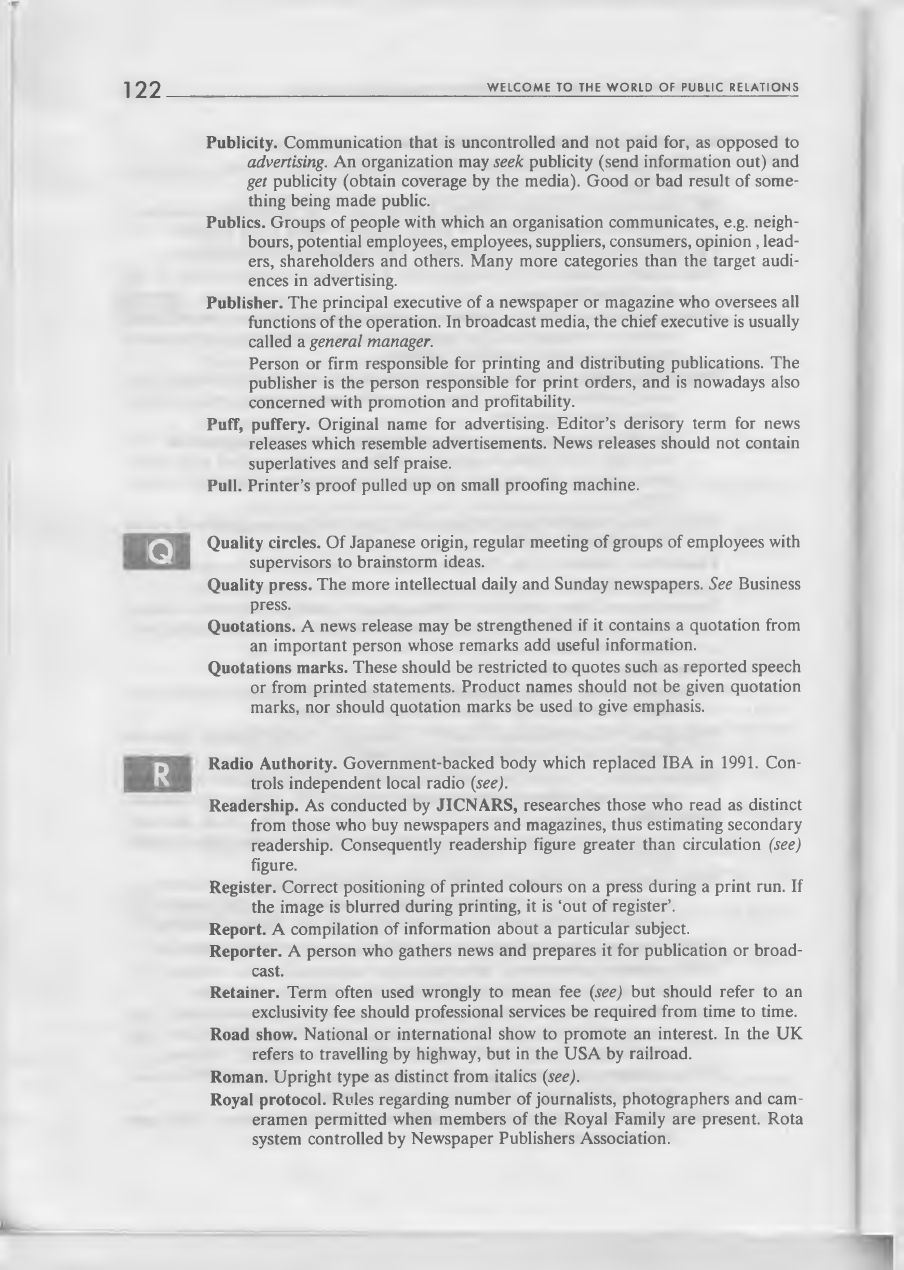
122
W E L C O M E T O T H E W O R L D O F P U B L I C R E L A T I O N S
Publicity.
Communication that is uncontrolled and not paid for, as opposed to
advertising.
An organization may
seek
publicity (send information out) and
get
publicity (obtain coverage by the media). Good or bad result of some
thing being made public.
Publics.
Groups of people with which an organisation communicates, e.g. neigh
bours, potential employees, employees, suppliers, consumers, opinion , lead
ers, shareholders and others. Many more categories than the target audi
ences in advertising.
Publisher.
The principal executive of a newspaper or magazine who oversees all
functions of the operation. In broadcast media, the chief executive is usually
called a
general manager.
Person or firm responsible for printing and distributing publications. The
publisher is the person responsible for print orders, and is nowadays also
concerned with promotion and profitability.
Puff, puffery.
Original name for advertising. Editor’s derisory term for news
releases which resemble advertisements. News releases should not contain
superlatives and self praise.
Pull.
Printer’s proof pulled up on small proofing machine.
Q
Quality circles.
Of Japanese origin, regular meeting of groups of employees with
supervisors to brainstorm ideas.
Quality press.
The more intellectual daily and Sunday newspapers.
See
Business
press.
Quotations.
A news release may be strengthened if it contains a quotation from
an important person whose remarks add useful information.
Quotations marks.
These should be restricted to quotes such as reported speech
or from printed statements. Product names should not be given quotation
marks, nor should quotation marks be used to give emphasis.
R
Radio Authority.
Government-backed body which replaced IB A in 1991. Con
trols independent local radio
(see).
Readership.
As conducted by
JICNARS,
researches those who read as distinct
from those who buy newspapers and magazines, thus estimating secondary
readership. Consequently readership figure greater than circulation
(see)
figure.
Register.
Correct positioning of printed colours on a press during a print run. If
the image is blurred during printing, it is ‘out of register’.
Report.
A compilation of information about a particular subject.
Reporter.
A person who gathers news and prepares it for publication or broad
cast.
Retainer.
Term often used wrongly to mean fee
(see)
but should refer to an
exclusivity fee should professional services be required from time to time.
Road show.
National or international show to promote an interest. In the UK
refers to travelling by highway, but in the USA by railroad.
Roman.
Upright type as distinct from italics
(see).
Royal protocol.
Rules regarding number of journalists, photographers and cam
eramen permitted when members of the Royal Family are present. Rota
system controlled by Newspaper Publishers Association.